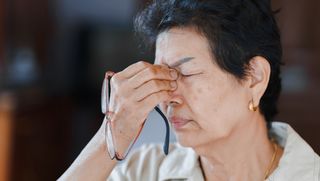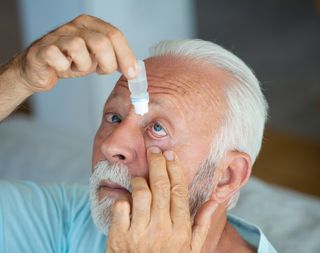What causes dry eyes?
Common factors that may contribute to dry eyes, and where to seek guidance if needed.

Summary
Dry eye disease is when your eyes don’t produce enough tears, or the tears evaporate too quickly. Managing dry eyes is important at all times and there can be many questions around dry eyes and low vision. Experiencing dry eye symptoms can impact your quality of life and making the most of your remaining vision.
What causes dry eyes?
Causes and risk factors contributing to dry eyes include:
- Irritants like dust or smoke.
- Age.
- Hormonal changes like pregnancy or menopause.
- Looking at screens over a long period of time.
- Autoimmune diseases such as Sjögren’s syndrome, lupus, or rheumatoid arthritis.
- Medications such as antihistamines.
- Contact lenses.
- A dry or windy environment.
What are the symptoms?
Symptoms of dry eyes include:
- Watery eyes.
- Tired eyes.
- Irritation like stinging or burning.
- A gritty feeling in your eyes.
- Red eyes.
- Blurred vision.
Types of dry eye
There are different types of dry eye caused by different underlying factors.
Here are the types of dry eye:
- Evaporative dry eye
- Aqueous deficient dry eye
- Mixed dry eye
What is the treatment for dry eye disease?
The treatment for dry eyes depends on the cause and the severity. Some of the treatment options available include:
- Artificial tears.
- Warm compresses (such as a face washer) applied gently to your eyelids (talk to your eye care professional about how to do this safely).
- Medications that can increase tear production.
- Eye lid treatments provided by your eye care professional.
- Intense Pulsed Light (IPL) laser treatment provided by your eye care professional.
- Tear duct plugs that can help to keep your tears or artificial tears in your eyes.
- In some cases, dry eye can be caused by the bottom eye lid being too loose, in these instances surgery can tighten the bottom eye lid and stop it from drooping.
- In some cases, your practitioner might recommend dry eye sleeping goggles to help manage dry eye disease.
Always speak to your GP or eye care professional about the best treatment options for you.
Types of artificial tears
Artificial tears, also known as eye drops, are used to lubricate dry eyes and provide relief from eye discomfort.
There are a multitude of artificial tears available in pharmacies and through your eye care professional. It can be overwhelming picking the best one for the cause and symptoms of your dry eye. Your eye care professional can provide advice on the best option for you.
Below is a summary of the types of artificial drops available:
- Lubricant eye drops: These are basic artificial tears that aim to provide temporary relief from dryness and irritation by lubricating the surface of the eye and are used mainly with aqueous deficient dry eye.
- Lipid-based eye drops: Lipid-based artificial tears contain oils that help stabilize the tear film and reduce evaporation, providing longer-lasting relief for dry eye symptoms, particularly associated with evaporative dry eye.
- Combination products: These contain both an aqueous supplement and lipid to address mixed type dry eye. These are often a good option if you don’t know the underlying cause of your dry eye.
- Gel eye drops: Gel-based artificial tears have a thicker consistency compared to traditional drops. They provide longer-lasting relief and are often recommended for overnight use.
- Ointments: Eye ointments are thicker than gel drops and provide prolonged lubrication. They are usually recommended for nighttime use due to their blurry vision effect, which can impair daytime activities.
- Hyaluronic acid eye drops: These eye drops contain hyaluronic acid, a substance naturally found in the eye. They provide intensive hydration and are suitable for people with severe dry eye symptoms or those undergoing certain eye surgeries.
Which artificial tears are best for me?
It is best to consult with an eye care professional to determine the most suitable type of artificial tears for your specific needs, as they can recommend the most appropriate option based on the underlying cause and severity of your dry eye symptoms.
Some drops are available without preservatives, and this can be important if you are also using glaucoma drops, are undergoing eye surgery or have sensitivities to preservatives.
How can I prevent dry eye?
Some of the preventative measures to avoid dry eye include:
- Use your drops regularly as recommended by your eye care professional.
- Wearing sunglasses outside to protect your eyes from wind.
- Blinking regularly when looking at screens for a long period of time.
- Using a humidifier for dry indoor environments.
- Avoiding excess air blowing into your eyes from hair dryers and fans.
- Avoiding or quitting smoking.
- Staying hydrated by drinking water and using artificial tears if needed.
For more information
- Read our 'What causes watery eyes' article to learn more.
- Always speak to your GP and eye care professional about the best treatment options for you.
- Please refer to the relevant instructions for use provided with your drops and consult your eye care professional for use, precautions, warnings and contraindications.
Did you find this article helpful?
Share your thoughts and help us make our resources better for everyone.
Are you applying your eye drops correctly?
It is important your eye drops are being applied correctly - otherwise they can become ineffective, or worse, lead to infection if your drops become contaminated.
